Saleswhale Blog | 18 Min Read
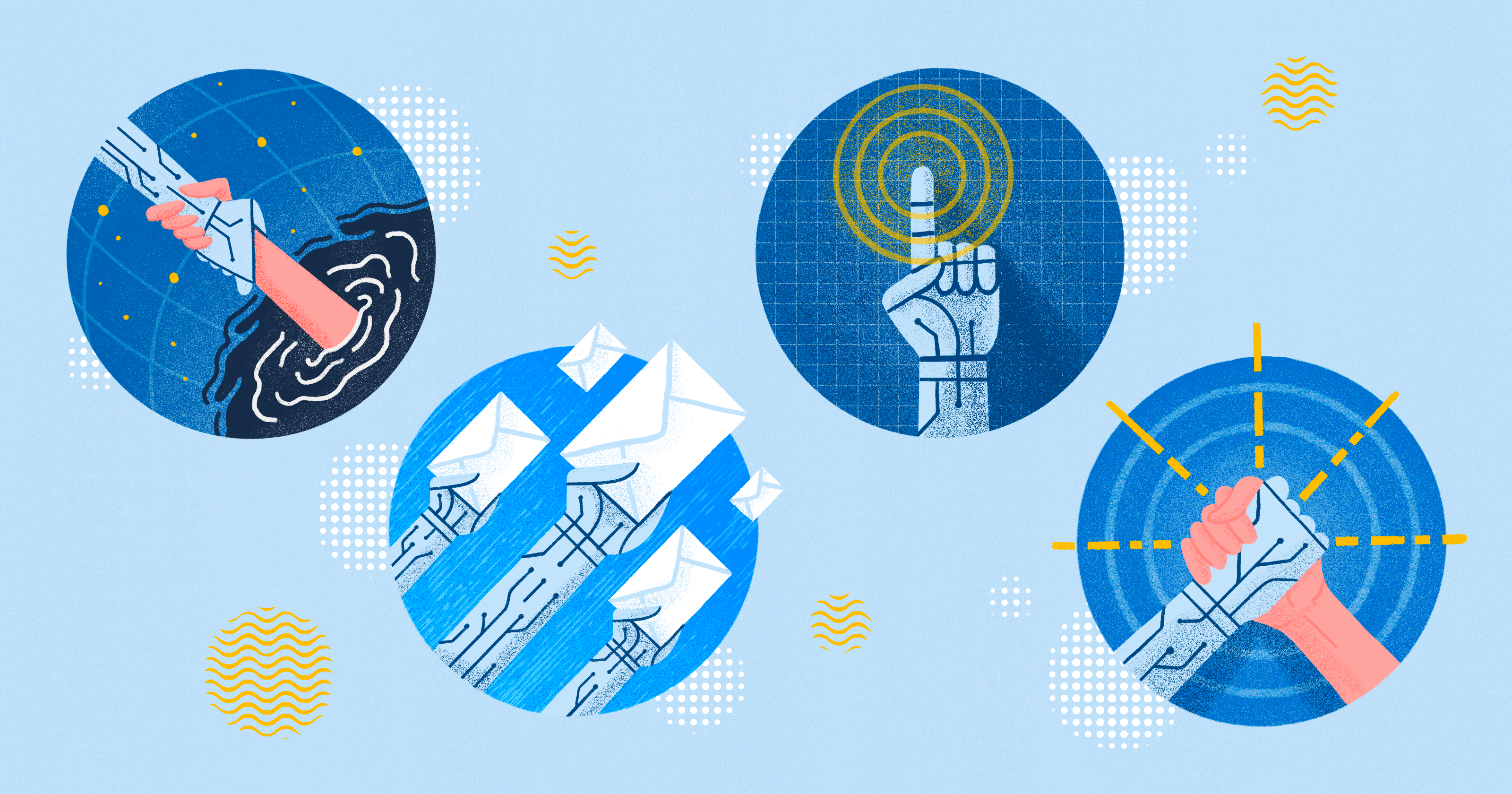
In 2017, Todd Berkowitz from Gartner predicted the “death of the MQL”.
CMOs and demand generation leaders, are starting to look beyond MQLs (marketing qualified leads). They want to see attributable revenue generated from marketing programs.
At Saleswhale, we call marketing leaders like these 2.0 marketers.
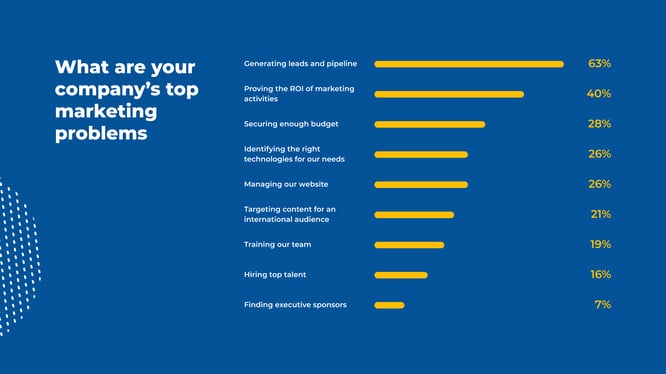
Source: Hubspot, The Ultimate List of Marketing Statistics
It's now 2020. The profound shift from MQLs towards revenue, inextricably ties the fate of Marketing to Sales.
If you generate a ton of qualified leads, but Sales doesn’t follow-up with them and convert them into revenue -- then your marketing program essentially failed at ROI.
In a similar vein, if you spend lots of resources on generating content, but your content is not being consumed - i.e. a gated white paper you spent months on may only end up getting hundreds of life-time downloads - it’s going to get increasingly hard to justify content marketing efforts to executive stakeholders.
"I would get quarterly bonuses based upon bringing in a specific number of leads. I invested in programs that drove leads and I consistently blew past my number. Those leads weren’t turning into closed deals and my boss got replaced because he wasn’t hitting the growth numbers. I did a series of webinars, got massive attendance and drove further engagement through a single email nurture after the call. I easily hit my MQL goals, but these didn’t convert into new deals either. All of the top of the funnel activity wasn’t going to change that in the short run." - Todd Berkowitz, Research Vice President, Gartner
With that, let's discuss the 4 challenges that demand generation marketers face.
"Businesses are scraping for incremental increases in marketing yields, close ratios, and leverage through technology - yet overlooking a gaping black hole that exists somewhere between their marketing and sales teams." - Ken Krogue, President and Founder, InsideSales.com
Most leads don’t get adequate sales follow up.
According to Ken Krogue, about 71% of inbound leads are wasted. In fact, just 27% of leads get contacted by sales.
One of our clients, a Fortune 500 company, generated over 2,000 leads in a quarter and realised that 1,000+ were never touched by sales.
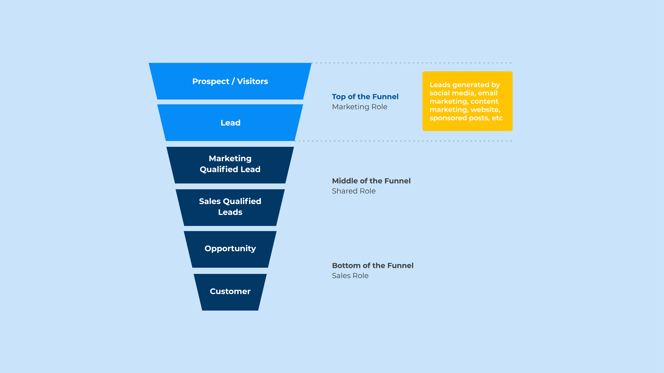
As a marketer, you probably spend a crazy amount of effort to increase lead conversion rates by a few percentage points. Testing call-to-actions, ad copy, segmentation, form fields etc.
Meanwhile, your sales counterparts are working hard to boost their closing rates by 5% or 10% through product training, standardized sales methodology, demo drills, objection handling, sales enablement etc.
Everyone is scraping for that incremental marketing/sales yield.
But it’s crazy that no one is looking at that Bermuda Triangle where so many leads go to die!
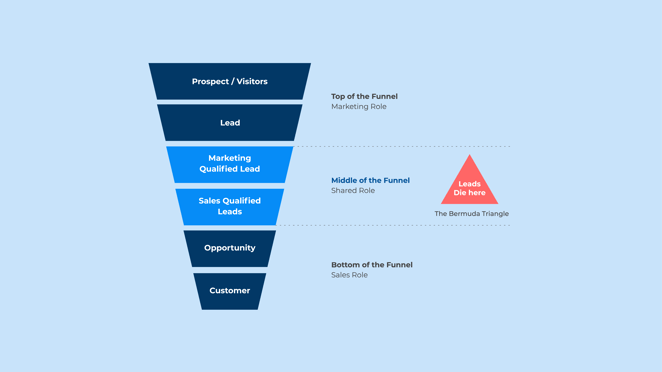
If you’re a marketer who cares about marketing’s impact on pipeline creation, this is incredibly frustrating.
The marketing budget that you lobbied and fought your CEO for, only resulted in 27% of leads generated ever getting spoken to.
That’s a huge waste in budget and efficiency.
Why does this happen? Are salespeople lazy? Absolutely not!
Leads slipping through the cracks is mostly a structural and alignment issue. Let’s deconstruct why.
“Hey, the leads you gave me - they are not sales-ready. They suck!”
This is a common perception salespeople have towards marketing qualified leads (MQLs).
According to Marketing Sherpa, 61% of B2B marketers send all leads to sales, but just 27% are actually qualified.
Let’s look at it from the perspective of a salesperson. Let's call him Andrew.
Marketing generates 100 MQLs and passes them to Andrew.
Marketing assures Andrew that these leads are ICP (ideal customer profile) and qualified. They have tripped some kind of lead score, and showed buying signals by interacting with content or by visiting the pricing page.
“We have screened all the tyre-kickers and non-ICP leads out. These are the Glengarry Leads”, Marketing proclaims.
The Glengarry leads
So, excitedly, Andrew blocks out 3 hours, precious hours away from existing customers and sales opportunities.
He starts calling and emailing. By the time Andrew gets to the bottom of the list, he has only booked 11 meetings, out of which probably only two will close.
The next month, Marketing hands another 100 MQLs to Andrew.
Same routine, same results.
Ten meetings booked. 1 or 2 deals closed.
By now, Andrew is fed up.
When Andrew receives the next batch of leads from Marketing, he’s going to cherry-pick those with nice-looking logos, and dump the rest into the rubbish bin.
Does this sound familiar to you?
An interesting statistic about B2B buyers
Here’s another statistic which will surprise many sales and marketing people:
45% of B2B leads, people who enquire about a product or service, will eventually buy.
But here are a couple of caveats:
They do end up buying, but not necessarily from YOU. Let that sink in.
They do end up buying, but eventually. Not necessarily NOW.
The last point is important to understand.
Salespeople often underestimate how long it takes for qualified leads to turn into sales:
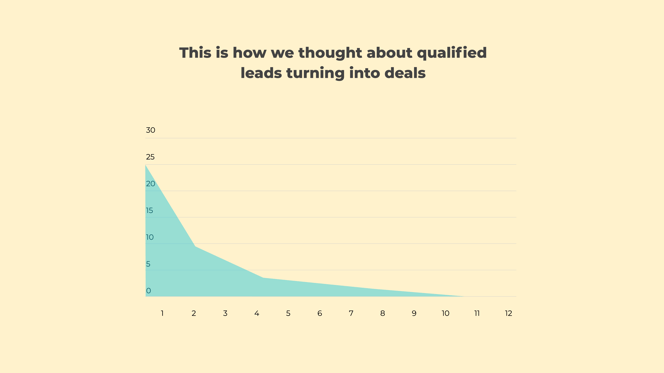
If 45 sales (out of 100 qualified leads) are eventually made, the buying behavior would look like the graph from the previous page. After all, leads do become stale, right?
Not really.
According to Marketing Donut, 63% of people requesting information on your company today will not buy for at least three months. 20% will take more than a year to purchase.
The actual, real-life behavior, looks more like the graph in red instead:
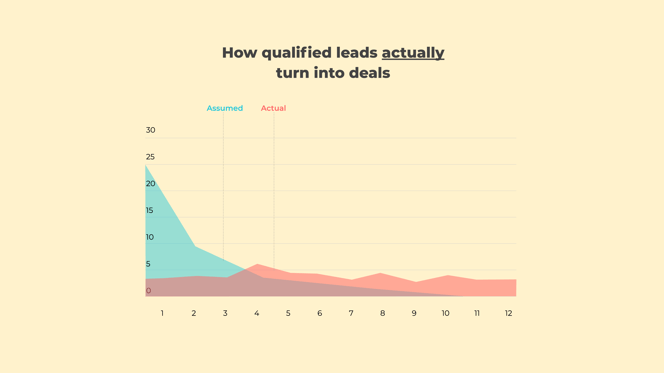
If we were to reason from first principles, it does make sense.
A lead could be anywhere in the buyer’s journey when they enquire.
Out of 45 qualified leads, maybe only 4-5 will be “sales-ready” at a given point in time. The rest are too early.
As a result, sales reps spend a lot of time chasing, calling, emailing prospects, only to be greeted by silence. Most prospects are simply not ready to speak to sales yet!
But a lead that is not “sales-ready” doesn't mean it’s a bad lead (so long as they are an ideal customer profile, or ICP).
Throwing out the baby with the bathwater
It’s easy to assume that these leads are not serious buyers, and throw the baby out with the bathwater.
This is exactly what most sales people, like Andrew, do - thinking the leads are “no good”, they move on to other seemingly “fresher” leads.
So Andrew never ever gets those 45 sales opportunities. He remains convinced that the leads were lousy, and Marketing is doing a poor job. What happens to those opportunities?
They end up going to your competitors.
"Marketing automation is one of those things that’s like sex in high school. Everybody’s talking about it, but no one’s actually doing it… or at least doing it in a way that anyone’s satisfied with." -- Hana Abaza, VP of Marketing, Uberflip
Most marketing automation tools give you the ability to score your leads in your database.
And lead scoring models are considered essential in modern marketing and sales departments.
The overarching idea of lead scoring is to improve sales productivity. You don’t want sales reps to be chasing down every single lead, as alluded to in Challenge #2.
Quick primer on lead scoring
Lead scoring is typically introduced when the volume of inbound leads becomes greater than what the sales team, or sales development (SDR) team, can humanly reach out to.
Here’s a quick primer on it works.
You assign scores to leads based on behavior, interaction and demographics.
Once a lead passes a certain threshold, it's passed to Sales, who are then expected to contact them.
False positives and false negatives
However, it’s likely that two things will happen:
Marketing will send over leads who are completely uninterested to talk to Sales (false positive)
Marketing will inevitably fail to send over some leads who are qualified, with a high propensity to buy (false negative)
This may be controversial, but here’s what we think:
The whole idea that marketers can design a lead scoring model that correctly scores leads according to their interest to talk to Sales is deeply flawed.
This belief creates a cascade of problems for revenue teams, leading to a net-loss of qualified opportunities for Sales.
If you are not careful with lead scoring, you end up running into endogeneity* problems which can be insidious and hard to debug.
*The word endogeneity is just a fancy word for having variables in your model affected by unforeseen variables.
Binary scoring
If we filter in only leads that are a good fit (ICP) -- then you realize there are two kinds of leads that really matter:
Leads that are willing to talk to Sales now
Leads that are not willing (or not ready) to talk to Sales now
If we can somehow take away the human & manual effort of reaching out to every lead... let’s suspend disbelief and assume this is possible -
You realise that leads will sort themselves into two groups: sales-ready "hand-raisers", and non "hand-raisers".
This is what we call Binary Scoring.
Handing over “hand-raiser” leads to Sales
We hand over the leads who are ready for a sales conversation immediately over to Sales.
We continue to nurture the leads who are not ready for a sales conversation, and reach out to them again after 90 - 120 days.
Across our entire customer base of hundreds of sales & marketing teams, we have consistently seen a lift of 30% to 250% of lead-to-opportunity conversion rate (and huge savings in Sales’ time) for teams that transitioned over to a Binary Scoring model.
Of course, this probably doesn’t answer the nagging question that you have now:
“How do I reach out to every single lead, and ascertain if they are ready to talk to Sales? How do I sort the hundreds, or thousands, of responses and deal with each one appropriately? How can I do this at scale?”
We will answer these questions in the latter half of the article.
Some companies employ sales development representatives (SDRs) or business development representatives (BDRs) to pre-qualify leads before sending them over to more senior sales reps or account executives (AEs).
For example, some demand generation teams would generate 1,000 registrations from a webinar, and hand the entire list over to their SDR team to reach out.
These SDRs are typically junior, entry-level employees. Most of them are fresh out of college.
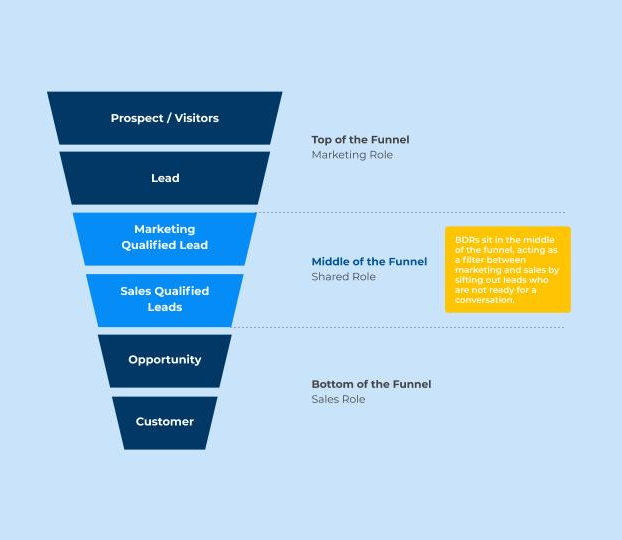
At first glance, this approach appears to solve most of the challenges above.
Your sales team can free up more time to focus on selling to customers, instead of qualifying and chasing down leads.
Not all sunshine and rainbows in SDR-land
Despite the flaws to this approach, this specialization in roles has become “conventional wisdom” in most modern sales and marketing organisations.
The benefits of having SDRs and specialising into “qualification” and “closing” roles, outweigh the downsides of not having this layer.
Companies like Salesforce used this strategy to great effect, propelling them to phenomenal growth in the early 2000s.
However, you are probably not Salesforce, and this is not the early 2000s.
There are some severe challenges and downsides to this strategy, namely:
Burnout
Cost
Culture & Management Overhead
Setting qualified meetings for sales people is often referred to as the “hardest job in sales”.
“Spending 100% of your time calling, emailing, and cold prospecting is a brutal way to spend all day, every day. You have to deal with the fact that most people don’t pick up the phone and that most people who do pick up say “no.” Almost all of your emails will not be replied to. Most of your replies will be a “no” as well.” -- Jonathan Vaudreuil, Director of BD, InsightSquared
Being a SDR is the hardest job in sales because you’re doing the dirty work for someone else.
This creates a high likelihood for burnout. And when SDRs end up leaving just after a few months, it can be costly in both morale and hard costs.
The average base salary for a SDR/BDR is $40K to $50K (closer to upper bound if you are in San Francisco). This is before commissions or OTE (on-target earnings).
That’s not all.
Once you factor in the fully burdened costs to run a proper SDR/BDR program, including managers, training, equipment, recruiting costs, office space, benefits, perks, taxes, insurance, etc., most companies are looking at costs approaching $115,200 / year.
And that’s just for one SDR/BDR.
Meanwhile, the typical SDR quota for setting qualified meetings for sales range from 4 - 12 meetings per month.
Assuming each BDR sets 8 meetings per month, that’s $1,200 per meeting.
SDRs also take time to ramp. And you will incur a significant chunk of these costs even while they ramp. This is where the burnout factor mentioned above comes into play. If a SDR ends up burning out just a few months after they start, it's an additional hit to your blended cost.
We had a customer who grew rapidly by hiring over 100 SDRs / BDRs to power their revenue engine. They would recruit them fresh out of college, starry-eyed and hungry.
Each SDR was given a laptop, a phone, and a quota to hit. If they didn’t make their quota, they were mercilessly culled.
Career advancement was limited - there were only so many open slots for senior sales roles. Everyone of those 100 SDRs / BDRs were vying for those limited open roles.
It was like the Hunger Games - kill or be killed.
Management overhead and cost to culture
The management overhead to manage a large cadre of BDRs is not trivial. You are looking at one manager per 6 to 8 SDRs, and one director per 3-4 managers.
SDR mismanagement can have severe ramifications throughout your organisation. If allowed to spread unbated, it can become toxic and slowly poison your organisation from within.
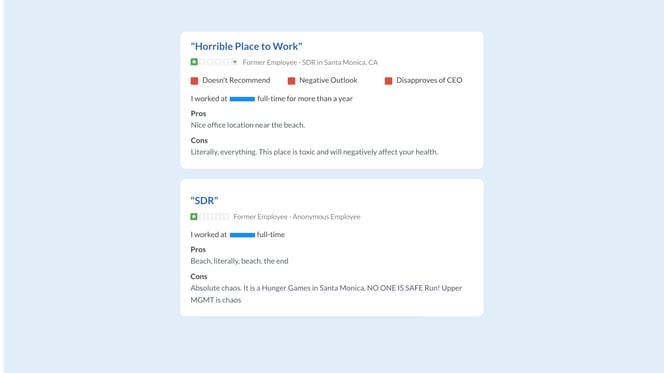 And of course, this affects your word-of-mouth, eNPS and Glassdoor reviews. It even can have negative downstream effects on your ability to attract even non-sales talent (like engineering, marketing etc.).
And of course, this affects your word-of-mouth, eNPS and Glassdoor reviews. It even can have negative downstream effects on your ability to attract even non-sales talent (like engineering, marketing etc.).
The issues above highlight the challenges which arise from over-indexing on human bodies to solve lead qualification and lead conversion problems.
These challenges are grudgingly accepted as a necessary evil by most marketing and sales teams. They have become part of the status quo. Because, up until recently, there hasn’t been an alternative.
A new hope
Over the last decade, AI and automation technology have been rapidly maturing, specifically in the natural language processing (NLP) subfield.
In 2020, modern AI assistants leverage advances in AI and NLP technology to work alongside their human counterparts.
Automating away tedious tasks that are ill-suited to humans.
So humans can focus on higher value work.
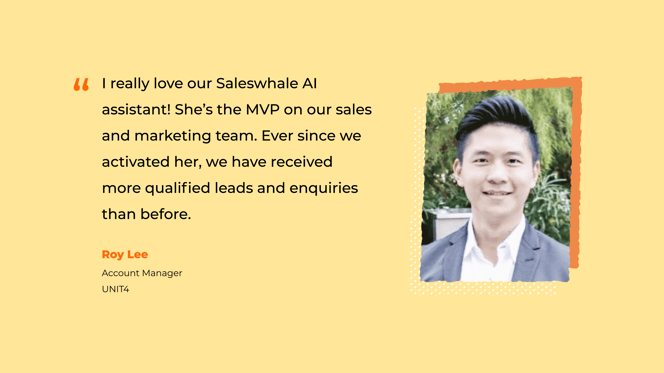
AI sales assistants help demand generation teams and salespeople automate tasks using artificial intelligence.
These tasks include lead qualification and follow-up, meeting scheduling, data collection/entry, and predictive demand forecasting.
Saleswhale (that's us!) deploys AI sales assistants that qualify, engage, and convert leads at scale.
Here you can see how an AI assistant sifts out a sales-ready, “hand-raiser” lead through email:
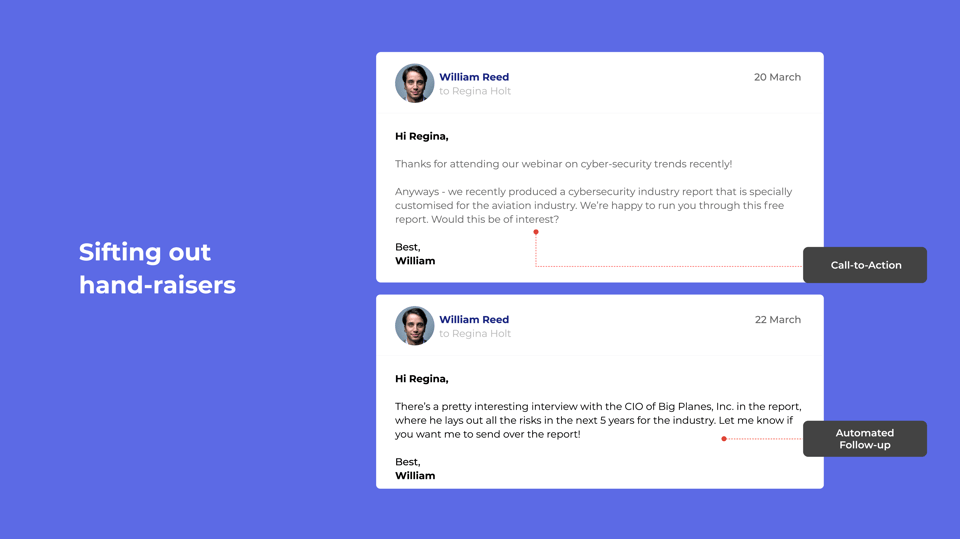
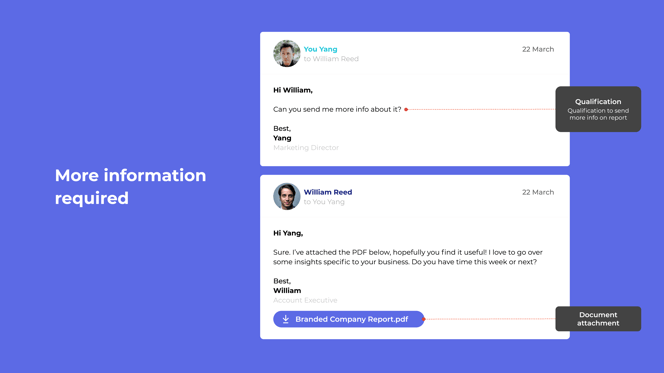

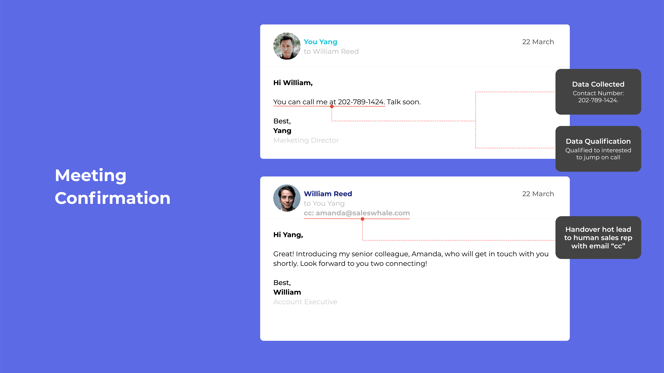
How does it work?
AI assistants are powered by the following machine learning and natural language capabilities:
Intent analysis and classification for email replies: this is how Saleswhale decides which paths to route the conversations down
Data collection: automatic extraction of phone numbers, follow-up dates and named entities from conversational exhaust
Thematic analysis to analyze replies and extract conversational data, for example: rejection reasons and topic clustering
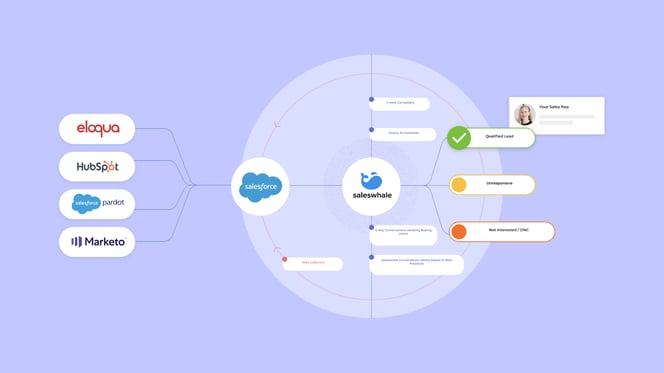 Friend or foe?
Friend or foe?
In case you’re worried, AI assistants aren’t a replacement for human sales reps or SDRs. Nor are they intended to replace any of your existing processes or marketing automation tools.
AI assistants solve very specific gaps in today’s B2B marketing and sales teams – the 4 major challenges and gaps that we mentioned above.
An AI assistant can rescue leads which fall into the Lead Bermuda Triangle.
AI assistants are especially organised and disciplined at re-engaging leads that have languished in databases for ages, and reigniting lost sales opportunities.
Our client, Randstad, had tens of thousands of stale leads generated over the years through content marketing, webinars, and events. These leads slipped through the cracks - their sales team had no time and bandwidth to reach out to these leads.
Within eight weeks of Randstad deploying an AI assistant to re-engage just 2,000 of those old leads, here’s what happened:
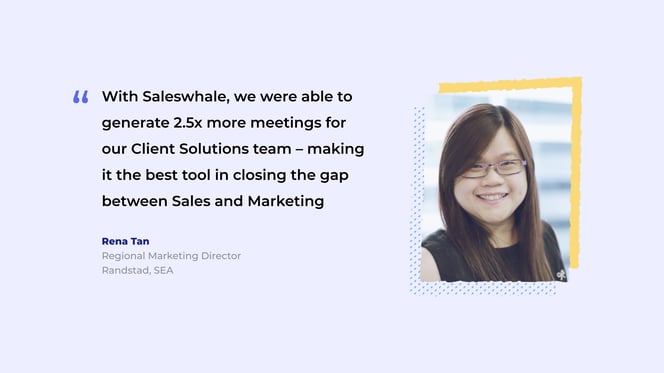
We ended the Challenges section with unresolved questions:
“How do I reach out to every single lead and ascertain if they are ready to talk to Sales? How do I sort the potentially hundreds, thousands, of responses that come in and deal with each one appropriately? How can I do this at scale?”
An AI assistant can easily handle thousands of conversations simultaneously, remembering conversation context and follow-up actions without missing a beat:
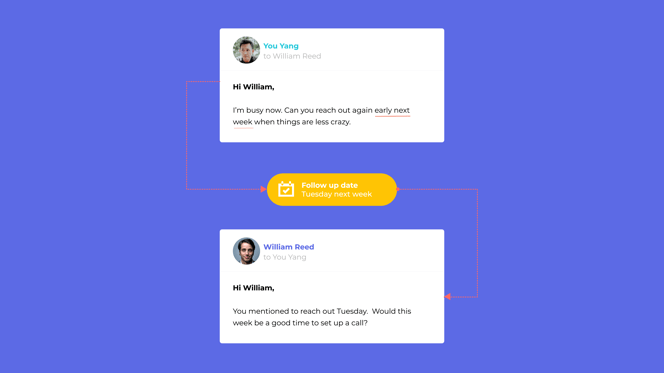
The idea is to only hand over “hand-raiser” leads who are ready for a sales conversation to Sales.
Lead recycling and “Return to Marketing”
The rest of the leads will be returned to marketing automation tools like Marketo or HubSpot for further nurturing.
The AI assistant will automatically continue to reach out to unresponsive leads again after 60 - 90 days (or based on certain intent triggers in Marketo) to re-engage them:

Through the above, Saleswhale’s AI assistants have helped over 200 companies, such as Zendesk, Nutanix, ON24, UNIT4 and Cisco achieve a 30% to 250% lift to lead-to-opportunity conversion rates.
That’s not all.
Most revenue teams also report the second-order effect of saving huge amounts of time for the Sales team - helping them sort through and sift out “sales-ready” leads ready for a sales conversation:
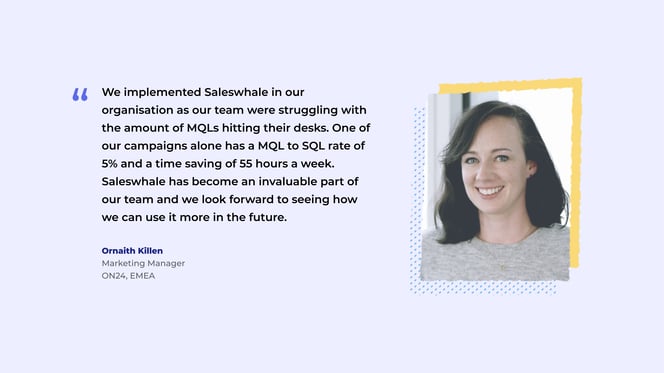
In Saleswhale, we believe in the concept of “every lead in motion”.
Every single lead that enters your marketing funnel should be constantly in motion – towards one desired outcome: becoming sales-ready.
Every lead in motion
A lead either opts-out, gets disqualified - or they are constantly moving towards becoming ready to hand over to the sales or SDR team.
Hence, to Saleswhale, every lead that is not actively engaged by your sales or SDR team has only two meaningful states:
Sales-ready
Not sales-ready
If you use marketing automation, or do lead scoring, here’s how Saleswhale can work in tandem:
Let your sales reps reach out to the best-tiered, hottest, leads.
Route the rest to your AI assistant.
After a certain SLA (service-level agreement), recycle unresponsive leads back to Marketing, for the AI assistant to engage.
Verifying the lead model
Your AI assistant can also be used to fine-tune your lead scoring model as well. Are your D-tier leads truly garbage?
For one of our clients, a global subsidiary of a public company, they ran a campaign that routed all their D-tier leads to their Saleswhale AI assistant.
These are the leads that no sales person in their right mind would want to call.
The results blew them away.
Their AI assistant managed to engage 34% of these "bottom-of-the barrel" leads. And generated more than 30 bona-fide sales opportunities that led to closed-won deals.
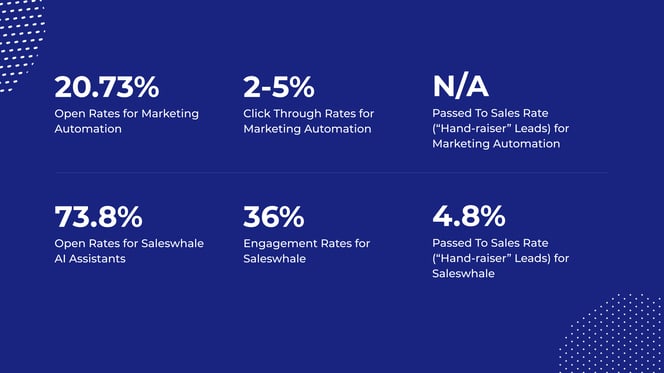
An AI assistant doesn’t quite replace the need for a SDR/BDR team. But it does make their lives much easier.
Here's how.
The AI assistant automates the follow-up for leads that are not sales-ready enough. Hence, the SDRs can focus on chasing down and qualifying the best-fit leads.
This prevents the need to scale up your SDR team linearly as your volume of leads increase.
Remember, your AI assistant is immune to the 3 challenges of a purely-human SDR strategy:
Burnout
Your AI assistant can work 24/7 - qualifying thousands of leads per month without breaking a sweat. She/he doesn’t complain, go on leave, or get psychologically affected by the litany of rejections.
Cost
The cost of a single AI assistant is a fraction of a fully-loaded human SDR. You can scale her/his capacity elastically up and down, depending on seasonality, without incurring “idling” costs like a human employee would.
Culture & Management Overhead
An AI assistant is just happy to be deployed. She/he would never gossip, bad-mouth her managers or colleagues, or write negative Glassdoor reviews (“I spend all day qualifying leads, it’s mundane and boring!”).
Most importantly, deploying an AI assistant helps prevent you from burning out your human SDR team.
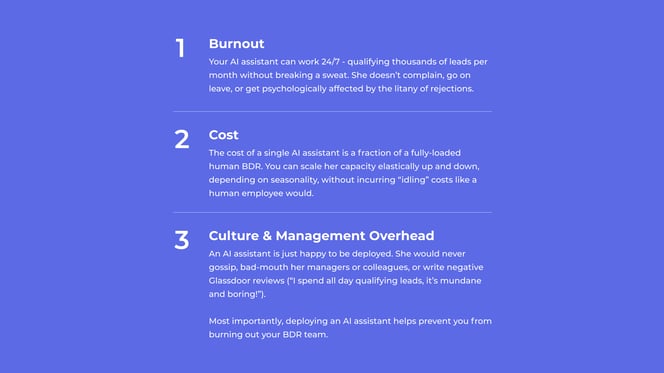
Let’s look at one last real-life case study.
This is the story of a company that achieved a huge business outcome by deploying an AI assistant to help with demand generation.
UNIT4’s marketing team generates thousands of leads a month from content, events, and other channels.
They had four inbound business development reps (BDRs), who were at full capacity following up with these leads.
While their lead scoring system did filter numbers down slightly, they were faced with two issues:
BDRs were cherry picking leads subjectively and missing good opportunities.
Only A-tier leads were being worked on by the BDR team. All other leads were left to marketing automation to passively nurture.
Elena Sanchez, Head of Marketing, wanted to improve the efficiency and output of her team’s lead engagement and qualification processes.
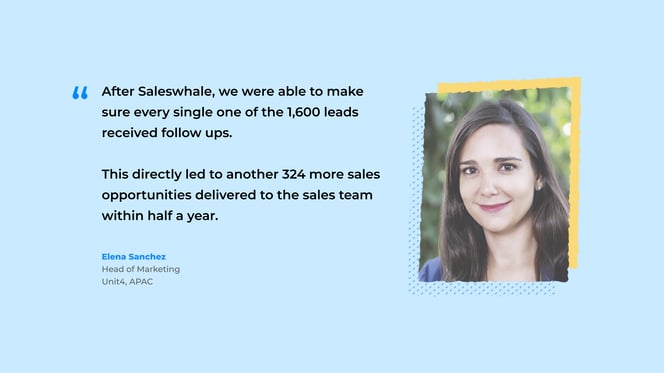
Before Saleswhale, UNIT4’s team could handle around 150 leads a month out of the 1,600 leads total that were coming in monthly.
After Saleswhale, Elena’s team now engages every single one of the 1,600 leads that come in monthly (courtesy of their new AI assistant colleague!).
This is a 10X increase in total number of leads successfully engaged in back-and-forth conversations.
This directly led to another 324 more sales opportunities delivered to the sales team within half a year - directly attributable sales pipeline worth tens of millions of dollars.
Now, the team no longer worries about leads slipping through the cracks and losing sales opportunities.
Converting Sales into fans of Marketing
UNIT4’s sales team is plenty impressed with the qualified leads they’ve received from marketing.
The favourite part of the sales teams' day?
Coming to work in the morning to find hot leads in their email inboxes, ready for a sales conversation - "served on a silver platter" by their AI assistant.
Enjoyed the read above? Want to download it as a PDF eBook? Download it here.
PS. We are building a free tool to help you increase webinar conversions dramatically - the industry's first Email Webinar AI Assistant. Check it out here.

Revenue-Driven Marketing AI Assistants Lead Conversion Automation

Co-founder & CEO at Saleswhale
Sign up for cutting edge ideas on conversational marketing, AI assistants and martech.

Saleswhale for Salesforce allows you to build powerful automated lead conversion workflows. This allows you to re-engage with your neglected marketing leads at...
19 APR 2021
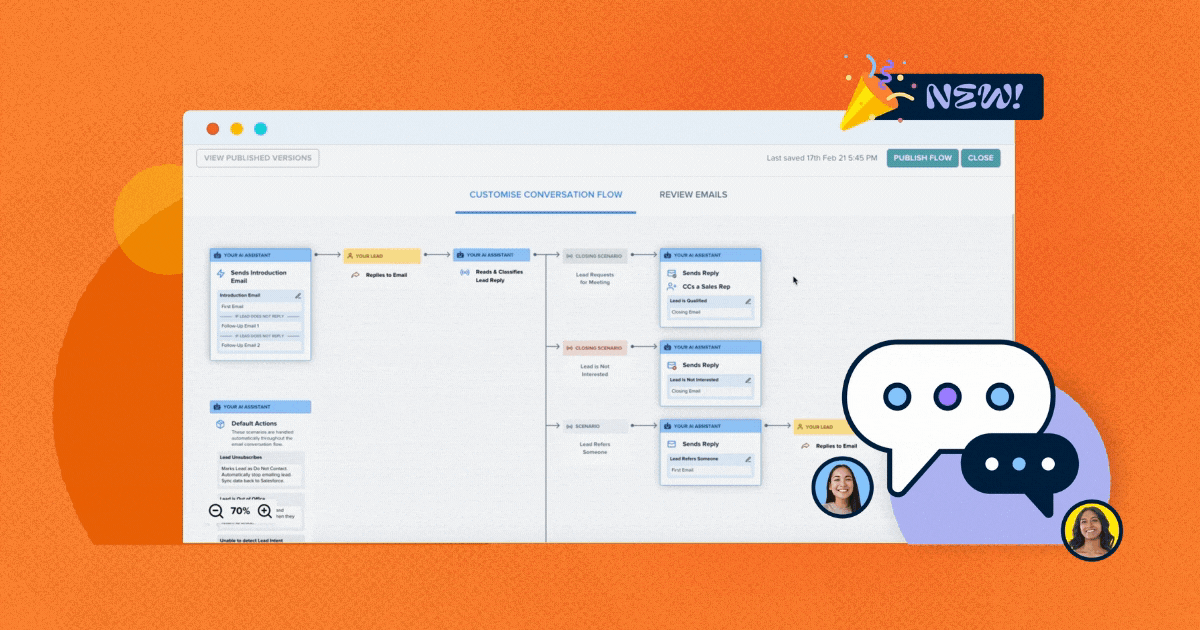
Demand generation and marketing teams generate more leads at the top of the funnel than ever in this new digital-first world. Saleswhale helps ensure those...
1 MAR 2021
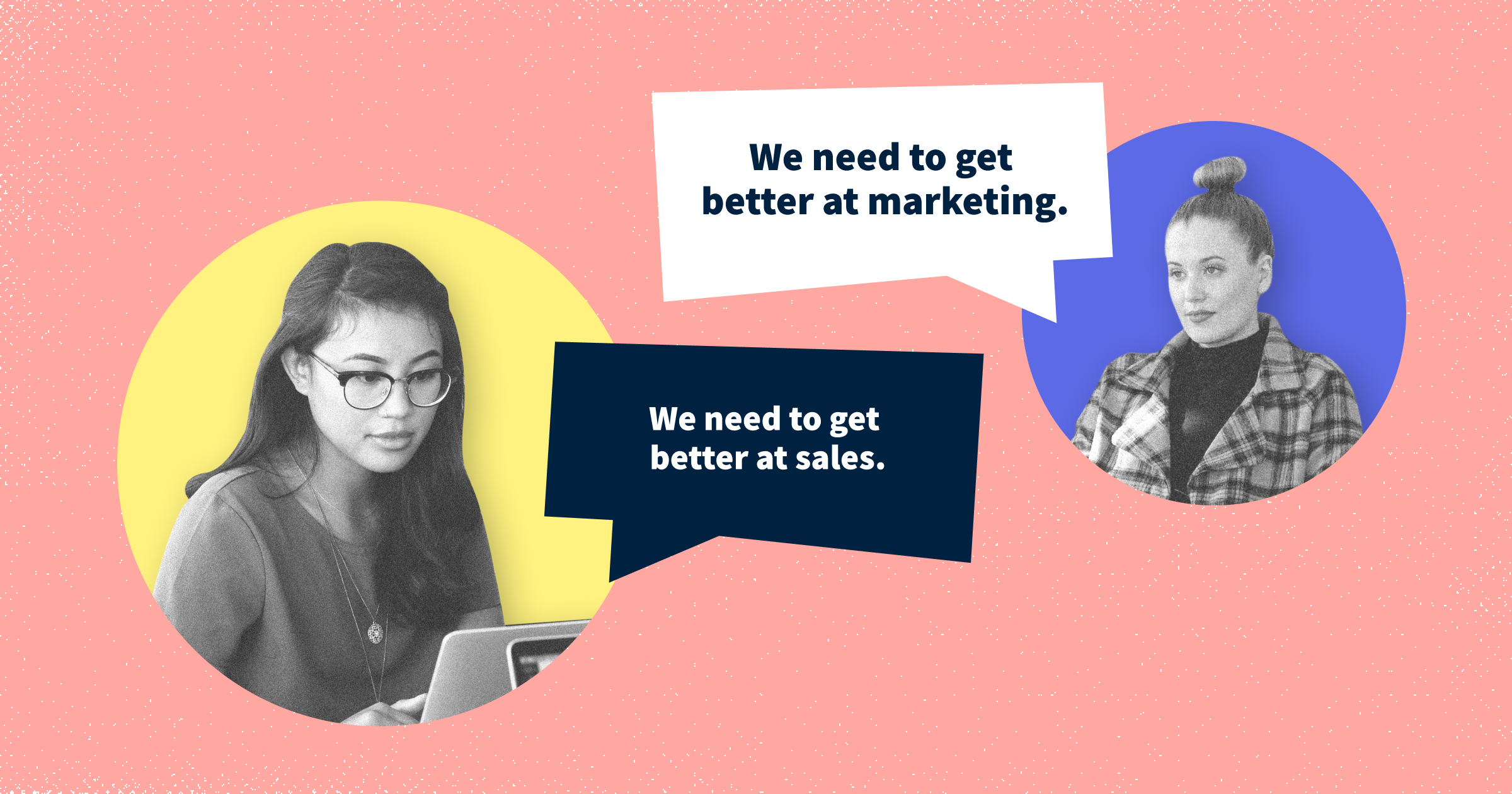
Marketers that focus on MQLs end up doing the wrong things in order to achieve the metrics. So I changed it.
16 JUN 2020
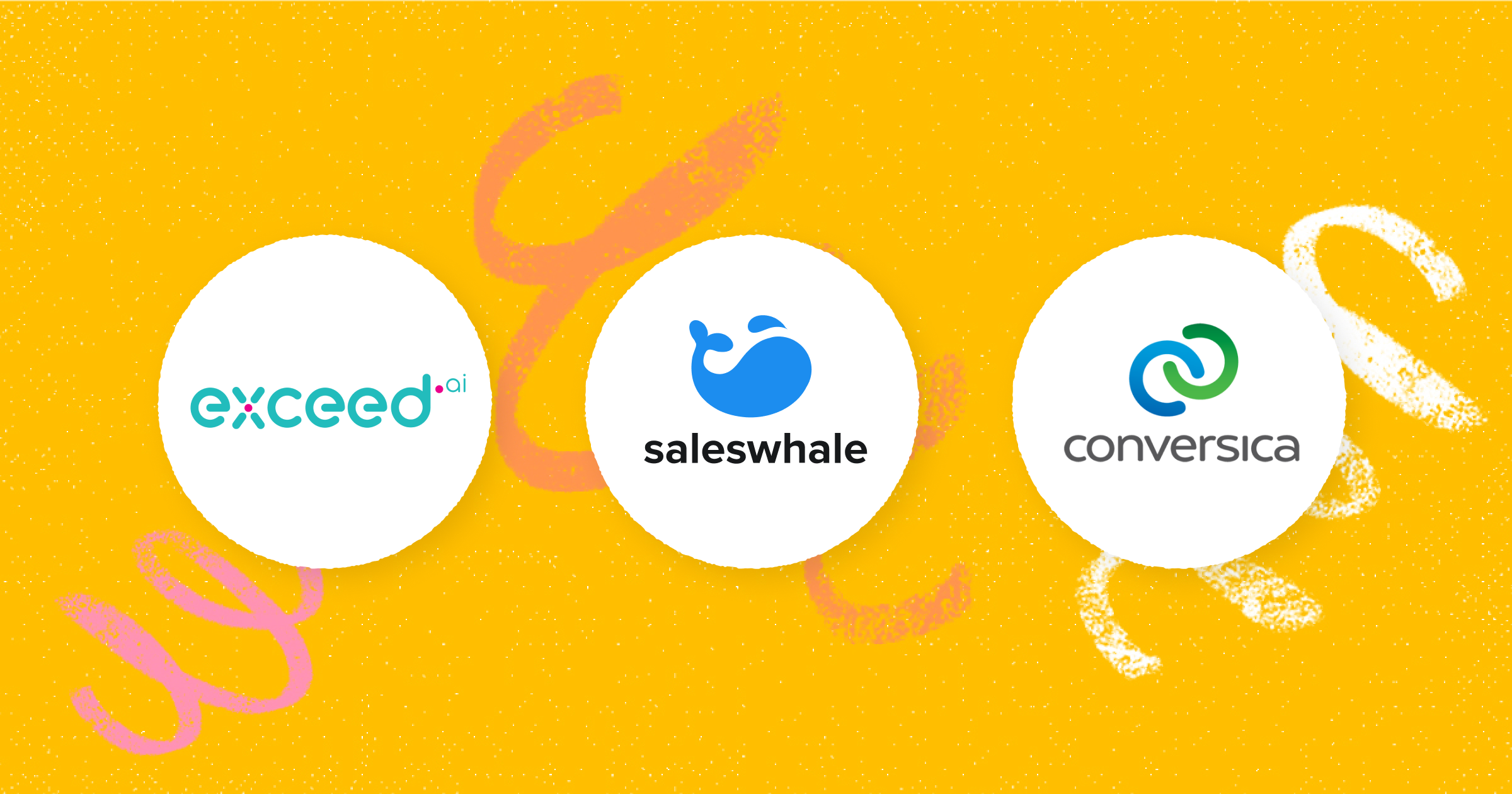
Conversica isn't the only player out there. Learn how Saleswhale and Exceed.ai compare and make an informed decision.
15 APR 2021
By providing your email you consent to allow Saleswhale to store and process the personal information submitted above to provide you the content requested.
You can unsubscribe at any time by clicking the link in the footer of our emails. For information about our privacy practices, please visit our privacy page.